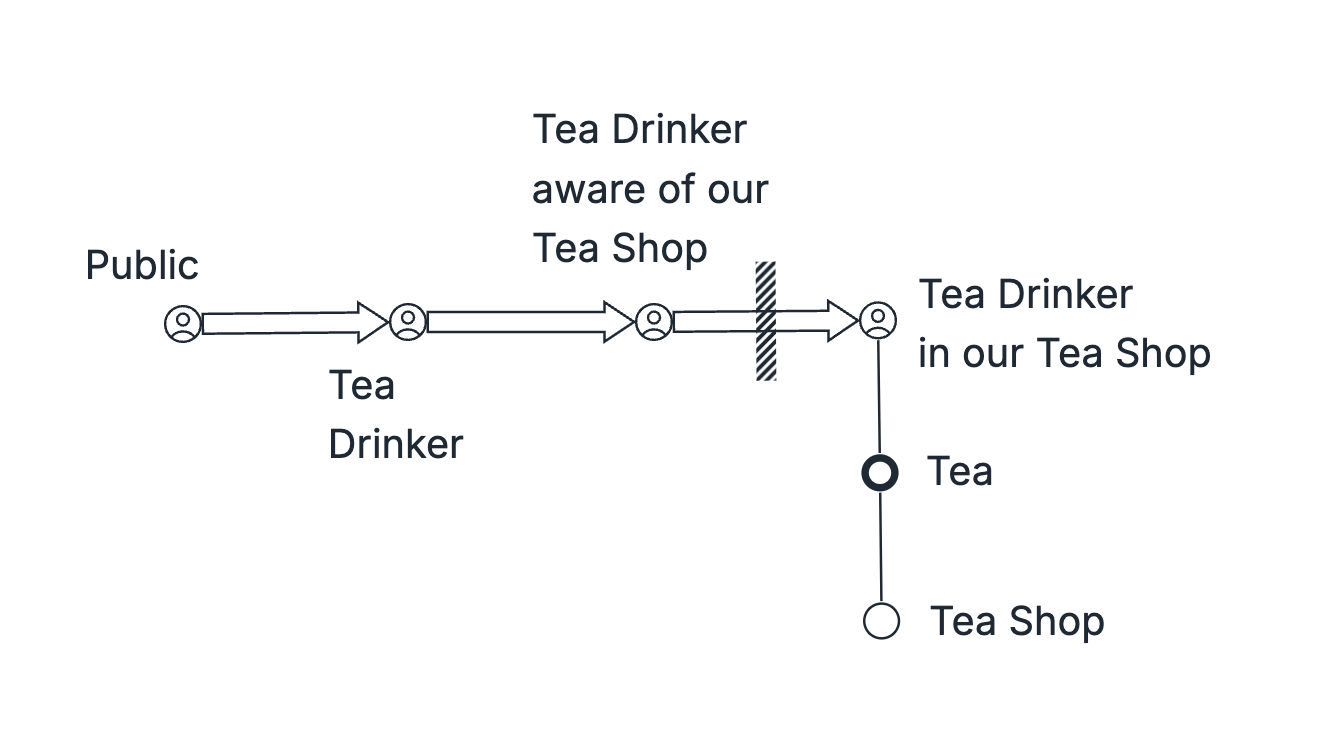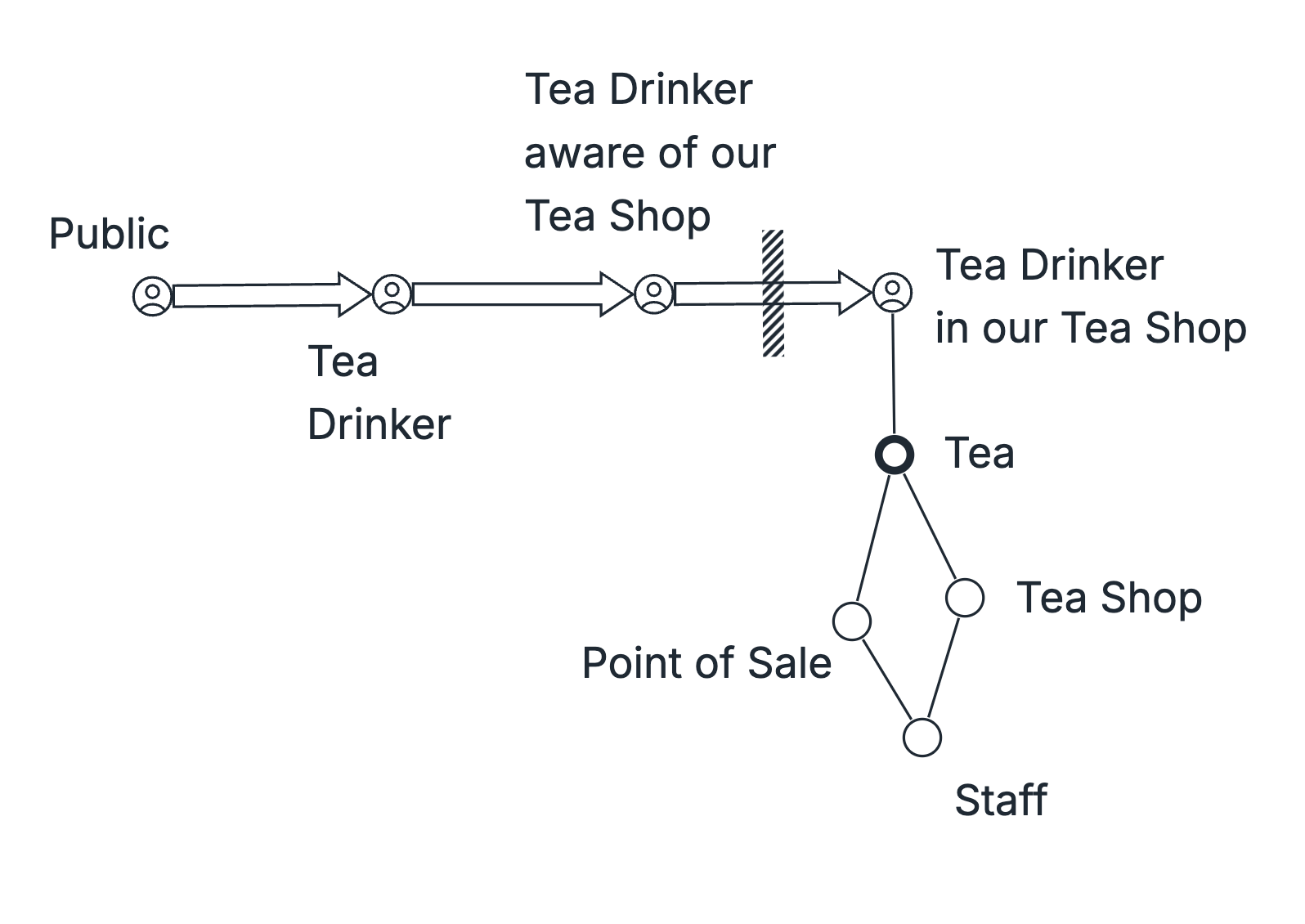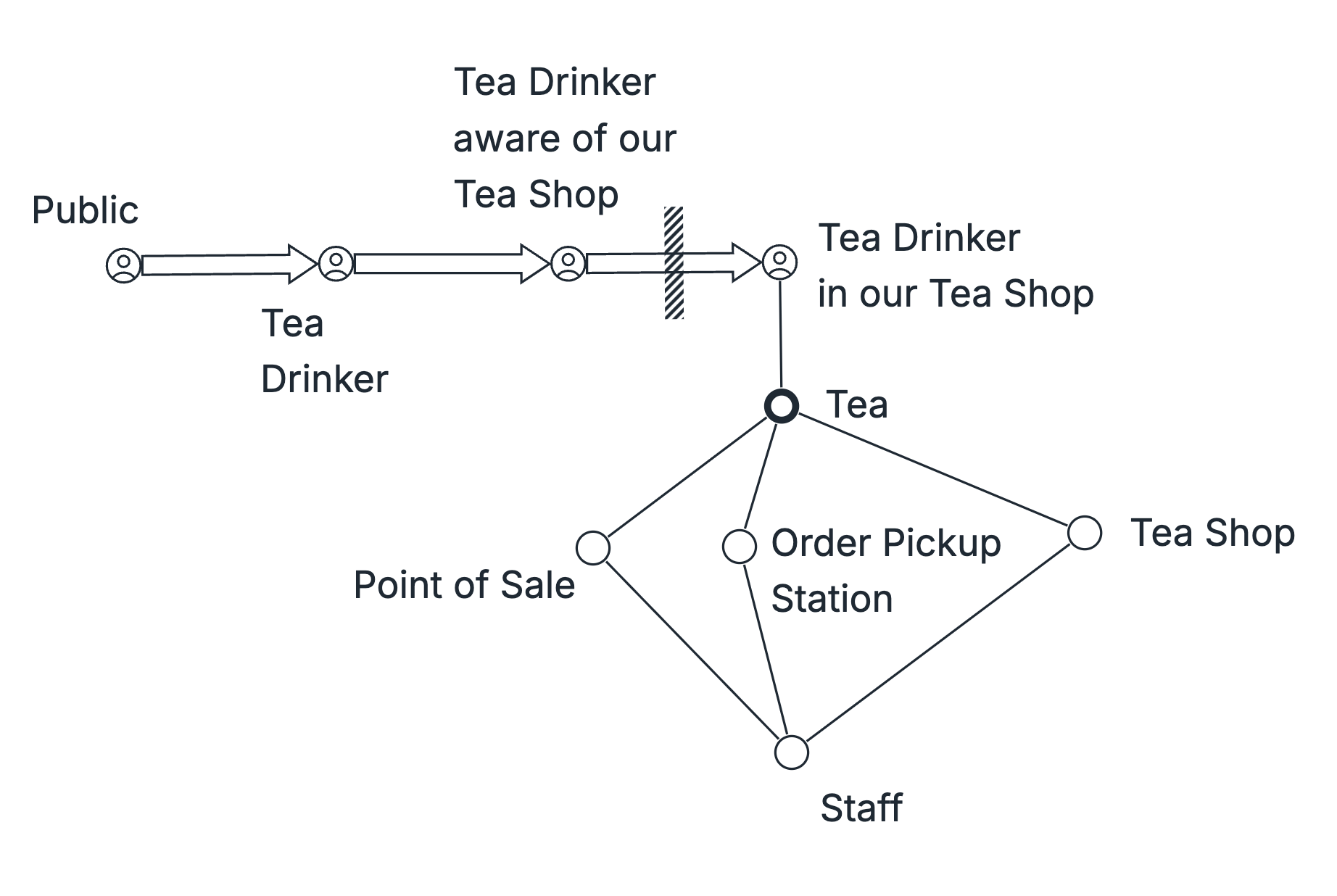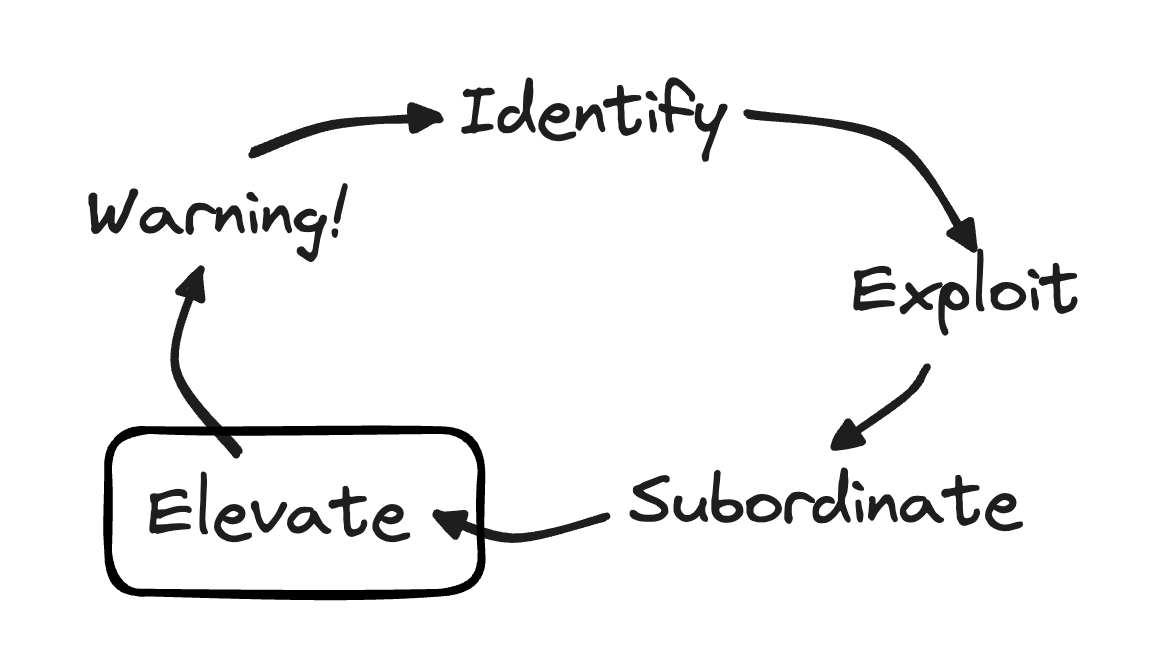Subordinate Everything Else to the Above Decision
Subordinate to User Constraint
Tea Shop User Constraint Example
Operational knowledge required
Deciding how to Subordinate to the Constraint requires operational knowledge of your system. This note is here to point out the boundary between strategy and operations that we find ourselves on. Strategy gets you to the point of Subordinating a particular input or output to the Constraint. How you will Subordinate it depends on what actions you can take in your specific operational context.
We start with the following scenario after identifying the User Constraint. As a reminder, the Constraint is not enough Tea Drinkers aware of our Tea Shop become Tea Drinkers in our Tea Shop.

We restate how we Decided to Exploit the above Constraint. We mentioned:
- provide good customer service and not have customers waiting in line
- sell additional items with the Tea to improve the flow of value
- allow for takeout with to-go cups as well as providing lids and stoppers to prevent spillage
Subordinate steps
Perform Subordinate Step 1 - For the Constraint or one of its inputs or outputs, add a single input or an output.
Let's begin by focusing on customers waiting in line. We add a Point of Sale as an input for the Constraint. It is an input in the sense that Tea Drinker in our Tea Shop places their order at the Point of Sale. It could also be an output if the customer receives their order at the Point of Sale.

Perform Subordinate Step 2 - Select actions to take to Subordinate the input or output to the Constraint.
What actions are we to take at the Point of Sale that will help provide good customer service and not have customers waiting in line?
- we could ensure that Tea purchase is the default and requires least interaction with the system by the Staff
- if we have a lot of cash transactions, we could ensure precounted change for common transaction amounts
What actions are we to take at the Point of Sale that will help sell additional items with the Tea to improve the flow of value?
- offer additional items to the customer when they order Tea
What actions are we to take at the Point of Sale that will help with allowing for takeout with to-go cups as well as providing lids and stoppers to prevent spillage?
- ask the customer if the order is takeout or not, making them aware that takeout is an option
- feature to-go containers prominently as an option at the Point of Sale
We now ask, did we identify all relevant inputs and outputs and Subordinated them to the Constraint?
In this case, no. So we repeat the steps.
Perform Subordinate Step 1 - For the Constraint or one of its inputs or outputs, add a single input or an output.
We identify that Staff are required to operate the Point of Sale as well as the rest of the Tea Shop. Saying this using our Value Chain vocabulary, Point of Sale depends on the Staff.

Perform Subordinate Step 2 - Select actions to take to Subordinate the input or output to the Constraint.
What actions are we to take with the Staff that will help provide good customer service and not have customers waiting in line?
- we could establish policy and training that a Staff member is always present at the Point of Sale (alternatively, that a Staff member prioritizes the Point of Sale and stops whatever they are doing and attends to a customer if one is present)
- train the Staff in how to provide good customer service
What actions are we to take with the Staff that will help sell additional items with the Tea to improve the flow of value?
- train the Staff to offer additional items to the customer when they order Tea
What actions are we to take with the Staff that will help with allowing for takeout with to-go cups as well as providing lids and stoppers to prevent spillage?
- train the Staff to ask the customer if the order is takeout or not
We ask again, did we identify all relevant inputs and outputs and Subordinated them to the Constraint?
Let's continue and repeat the steps.
Perform Subordinate Step 1 - For the Constraint or one of its inputs or outputs, add a single input or an output.
This time, let's say that we notice that the line doesn't move when the customer waits for the order at the Point of Sale. So, because we are Subordinating to the Constraint and part of that is to reduce line waiting time, we introduce a new component Order Pickup Station.

Perform Subordinate Step 2 - Select actions to take to Subordinate the input or output to the Constraint.
What actions are we to take at the Order Pickup Station that will help provide good customer service and not have customers waiting in line?
- in this case, create the Order Pickup Station
- train the Staff to call out names when order is ready at the Order Pickup Station
What actions are we to take at the Order Pickup Station that will help sell additional items with the Tea to improve the flow of value?
- the order was already placed, but perhaps a prominently placed advertisement of additional items available for purchase in the future
What actions are we to take at the Order Pickup Station that will help with allowing for takeout with to-go cups as well as providing lids and stoppers to prevent spillage?
- supply the Order Pickup Station with napkins and drink carriers
We ask again, did we identify all relevant inputs and outputs and Subordinated them to the Constraint?
For the purpose of this example, let's stop here.
Summary and reflection
The Subordinate two-step procedure above prompted us to add detail to the Value Chain in order to Subordinate everything relevant to the Constraint. Once again, you are not modeling the entire Value Chain, but only the relevant portions for this particular step.
Furthermore, the two-step procedure generated (possibly a lot of) actions to take within the system. Since these actions are in service of Exploiting the Constraint, you should observe immediate improvement at the Constraint, and therefore in the entire flow of value of your system.
These actions could take time. Here is a list of everything generated in the example above:
- we could ensure that Tea purchase is the default and requires least interaction with the system by the Staff
- if we have a lot of cash transactions, we could ensure precounted change for common transaction amounts
- offer additional items to the customer when they order Tea
- ask the customer if the order is takeout or not, making them aware that takeout is an option
- feature to-go containers prominently as an option at the Point of Sale
- we could establish policy and training that a Staff member is always present at the Point of Sale (alternatively, that a Staff member prioritizes the Point of Sale and stops whatever they are doing and attends to a customer if one is present)
- train the Staff in how to provide good customer service
- train the Staff to offer additional items to the customer when they order Tea
- train the Staff to ask the customer if the order is takeout or not
- in this case, create the Order Pickup Station
- train the Staff to call out names when order is ready at the Order Pickup Station
- the order was already placed, but perhaps a prominently placed advertisement of additional items available for purchase in the future
- supply the Order Pickup Station with napkins and drink carriers
You are now doing strategy!
Richard P. Rumelt wrote that good strategy has a kernel made of three parts1:
- diagnosis that explains the nature of the challenge
- guiding policy for dealing with the challenge
- coherent actions required to carry out the guiding policy
In this sense, you performed diagnosis when you Identified the System Constraint. You created the guiding policy when you Decided How to Exploit the System's Constraint. And now, you generated a set of coherent actions by Subordinating Everything Else to the Decision.
While there is still much more to strategy, you are on your way.
Rumelt, R.P. (2012), "Good Strategy/Bad Strategy: The Difference and Why It Matters", Strategic Direction, Vol. 28 No. 8. https://doi.org/10.1108/sd.2012.05628haa.002
Up next
After taking action in your system and observing the effects, you may need to revisit the Subordinate steps above.
Once you feel that you Subordinated everything to the Constraint, then it may be time to Elevate the System's Constraint, proceed there next.
If you are curious what Subordinating to the Constraint is like for User Need or Component, visit the Subordinate to User Need Constraint or Subordinate to Component Constraint lessons.

Go back
Subordinate Everything Else to the Above Decision
Learn to subordinate all non-constraints to the primary constraint in your value chain. This guide helps identify relevant non-constraints and ensure efficient flow of value through the system.

Up next
Elevate the System's Constraint
Explore the process of elevating the system's constraint by stepping out of the process flow and considering evolutionary stages. Learn how to identify, exploit, and elevate constraints within your system.
